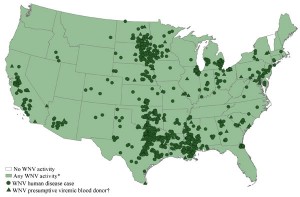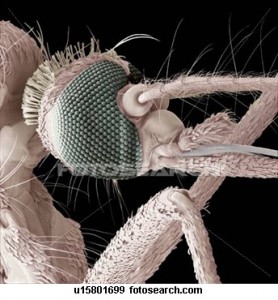
The CDC has released reports of West Nile Virus throughout the United States. The map here is from the CDC.gov pages and states:
” The map displays white areas that represent no WNV activity reported, light green areas that represent any WNV activity* , dark green circles that represent disease cases, and dark green triangles that represent presumptive viremic blood donors.
* Includes WNV human disease cases, presumptive viremic blood donors, veterinary disease cases and infections in mosquitoes, birds, and sentinel animals.
† Presumptive viremic blood donors have a positive screening test which has not necessarily been confirmed.
Map shows the distribution of WNV activity* (shaded in light green), human infections (dark green circles), and presumptive viremic blood donors (dark green triangles) occurring during 2012 by state. If West Nile virus infection is reported from any area of a state, that entire state is shaded.” http://www.cdc.gov/ncidod/dvbid/westnile/Mapsactivity/surv&control12MapsAnybyState.htm
Again, according to the CDC, “One thousand three hundred thirty-one human West Nile virus infections have been reported to CDC ArboNET from Alabama, Arizona, Arkansas, California, Colorado, Connecticut, Florida, Georgia, Idaho, Illinois, Indiana, Iowa, Kansas, Kentucky, Louisiana, Maryland, Massachusetts, Michigan, Minnesota, Mississippi, Missouri, Montana, Nebraska, Nevada, New Jersey, New Mexico, New York, North Carolina, North Dakota, Ohio, Oklahoma, Pennsylvania, South Carolina, South Dakota, Tennessee, Texas, Virginia, and Wisconsin.”
The reported number who have died is said to be 41 out of 1,118 cases in the USA across 38 states. According to a CBS report dated August 22, 2012 @ 4:11 PM , ” the infection has been found in mosquitoes or birds in 47 states as of Tuesday August 21, the last day the agency collected data. The only states not reporting West Nile activity are Alaska, Hawaii and Vermont.” This statement was made by Dr. Lyle Peterson, director of the division of vector-borne infectious diseases at the CDC. Peterson was also quoted as saying that the USA is in the midst of “one of the largest West Nile outbreaks ever seen.” http://www.cbsnews.com/8301-504763_162-57498462-10391704/cdc-dramatic-jump-in-west-nile-virus-cases-as-us-faces-one-of-largest-outbreaks-ever-seen/

What to watch for and how WNV is contracted?
The main route of human infection is through the bite of an infected mosquito from a single mosquito, so the CDC recommends that ” the easiest and best way to avoid the virus is to prevent getting a mosquito bite in the first place.”
What are the symptoms of WNV?
Keep in mind that about 80 percent of people who are infected with the virus won’t show any symptoms, but for 20 percent they may develop the following:
a fever,headache, body ache, vomiting, swollen lymph glands or a skin rash
One in 150 will develop:
high fever, neck stiffness, convulsions, vision loss, paralysis, coma and other neurological effects that may be permanent – or even death.
**People over 50 and those with compromised immune systems are at the highest risk.
The CDC reports that “Of all the reported cases, 75 percent are found in Texas, Mississippi, Louisiana, South Dakota and Oklahoma. Half of all reported cases are in Texas.”
What is being done abut the outbreak?
According to a CBS report with the director of the CDC:
” Dallas and other cities have taken to aerial spraying of insecticides, but officials warned this won’t kill all the mosquito sources, especially if it rains and there is stagnant water left where mosquitoes may breed.
“Therefore it is important for people to continue taking steps to prevent mosquito bites,” Peterson said at the press conference.
Some suggestions:
Health Pop, in their August 17, 2012 3:20 PM report stated:
“Apply insect repellant that contains an EPA-registered active ingredient, such as DEET, to skin or clothing before you head out doors. Bassett said many people don’t realize the prime times to get bit are dusk and dawn, and people may not worry about their bug bite risk when they are outdoors, or camping or at the beach.
***EPA characterizes the active ingredients DEET and Picaridin as “conventional repellents” and Oil of Lemon Eucalyptus, PMD, and IR3535 as “biopesticide repellents”, which are derived from natural materials. For more information on repellent active ingredients see (http://www.epa.gov/pesticides/health/mosquitoes/ai_insectrp.htm).***
Other Preventive Actions to Avoid Getting Bitten:http://epa.gov/pesticides/insect/preventive_actions.htm
The CDC adds that people should not spray repellants under clothing, over open cuts, wounds or irritated skin, nor near the eyes, mouth or directly on the face. Other repellants containing Picaridin may be used, and for those concerned with chemicals, there is oil of lemon eucalyptus. But Bassett says with natural products the protection likely won’t last as long.
“You can prevent 90 to 100 percent of bite reactions by applying the appropriate insecticide,” he said. Such tips can be applied to preventing other insect-borne diseases, like Lyme disease or babesiosis.
After returning indoors, wash the skin with soap and water, this is particularly important when repellants are used repeatedly in a day or on consecutive days, the CDC says. Treated clothing should be washed also before it is used again. People who have an allergic reaction to the repellant should see a doctor.
Health officials also recommend draining standing water, where mosquitoes breed.”
All worthy suggestions. We will follow this story closely and report any changes , and of course we will report on the aerial spraying so that you can remain indoors during these aerial spraying days .


West Nile virus (WNV) is most commonly transmitted to humans by mosquitoes. You can reduce your risk of being infected with WNV by using insect repellent and wearing protective clothing to prevent mosquito bites. There are no medications to treat or vaccines to prevent WNV infection. Fortunately, most people infected with WNV will have no symptoms. About 1 in 5 people who are infected will develop a fever with other symptoms. Less than 1% of infected people develop a serious, sometimes fatal, neurologic illness..,^-
Please do read our new web-site
http://www.healthmedicinedigest.co
ANYBODY who wants to help prevent further corruption please email me im going to need all the help i can get. things are getting bad so please contact me email:unknownweathers@aol.com
Was there any wnv tainted blood in illinois? Since I got my transfusion I have been sick and diagnosed with an autoimmune disorder. Thx.. any info would be useful